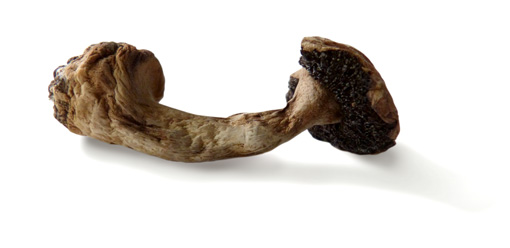Dehydrated Shiitake Mushroom
Lentinula edodes (Fungus amungus)
Anonymous donor
c. 1992
Weight: 3 g
Length: 8 cm

This mushroom was overlooked and remained undetected by a cook until after it had dried and shriveled. This specimen has a long, slightly curved priapic stem. It appears to be a shiitake mushroom. Shiitake are among the saprophytic mushrooms, part of nature’s clean-up crew. Fungus decomposes dead material from plants and other organisms, and releases carbon, an element essential for life.
Fungi are everywhere. Seen and unseen. Their varieties outnumber plants. These numbers, however, are not reflected in this museum’s collection, where plants dominate.
Fungi are more closely related to animals than to plants. The cell walls of fungi are made of chitin, the same substance crustacean shells and insect exoskeletons are made of; yet like plants, fungi are largely made up of water and fiber.
Plants create food by converting sunlight into energy which they store as starch, but both fungi and animals don’t make their own food. Instead, they manufacture enzymes to digest food obtained through their diet. In animals, the digestive organ is on the inside—food is first ingested (swallowed), then digested. But in fungi, it’s the opposite. The digestive organs are on the outside. External branching filaments called hyphae excrete exoenzymes which first digest (break down) the food, then ingest the nutrients. NEXT >